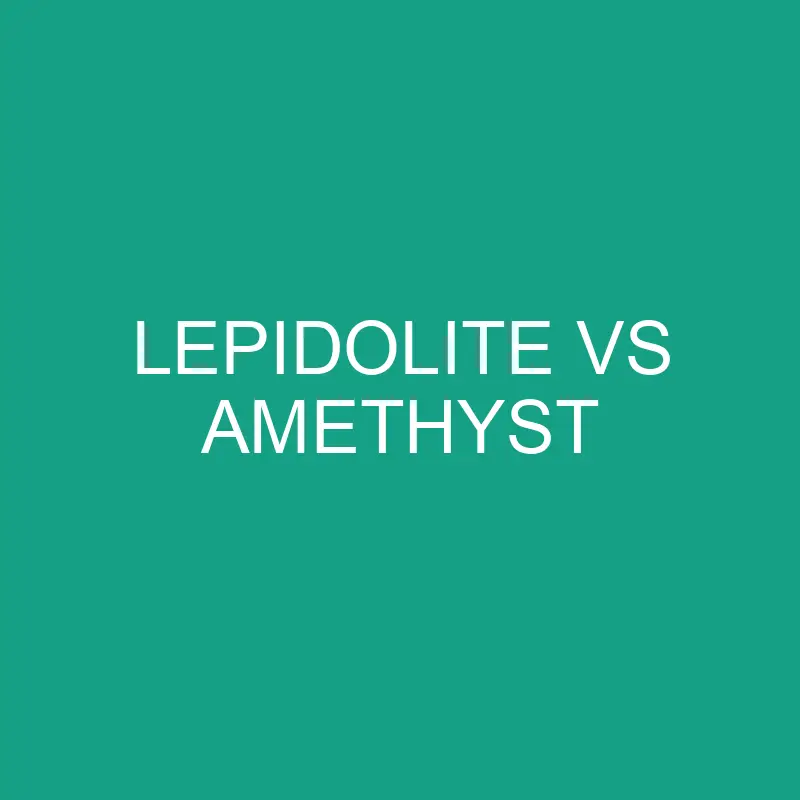A Tranquil Symphony of Purple Gemstones
In the kaleidoscopic world of gemstones, purple hues hold a special allure, and two gems that stand out in this enchanting spectrum are Lepidolite and Amethyst. Both gems exhibit captivating shades of purple, but they each have unique features, geological origins, and metaphysical properties. In this comparative exploration, we will delve into the distinctive characteristics of Lepidolite and Amethyst, unveiling the tranquil symphony they bring to the world of gem enthusiasts.
Post Contents
Lepidolite: The Soothing Lavender Stone
Origins and Geological Background:
- Composition: Lepidolite is a lithium-rich mica mineral, belonging to the phyllosilicate group.
- Color: Lepidolite showcases shades of purple, ranging from pale lavender to deep violet. It often contains other colors, such as pink and white, due to the presence of minerals like lithium, aluminum, and manganese.
- Formation: It typically forms in granite pegmatites and is often associated with other lithium-bearing minerals.
Physical Properties:
- Color and Appearance: Shades of purple, often with a silvery or pearly luster.
- Transparency: Transparent to translucent.
- Crystal Structure: Lepidolite belongs to the monoclinic crystal system.
- Hardness: It has a hardness of 2.5-3 on the Mohs scale.
Origins and Mining:
- Locations: Lepidolite is found in various locations globally, including Brazil, Madagascar, the United States, and Russia.
- Mining: Extracted through traditional mining methods, Lepidolite is often found alongside other lithium-bearing minerals.
Metaphysical Properties:
- Calm and Tranquility: Lepidolite is associated with promoting calm and tranquility, making it a popular choice for those seeking stress relief.
- Emotional Healing: It is believed to aid in emotional healing and balance, providing a sense of peace.
Uses in Jewelry and Art:
- Jewelry: Lepidolite is occasionally used in jewelry, especially in beaded necklaces and bracelets.
- Carvings and Cabochons: It is also fashioned into cabochons and carvings to showcase its unique color and texture.
Amethyst: The Royal Purple Quartz
Origins and Geological Background:
- Composition: Amethyst is a variety of quartz, composed of silicon dioxide with traces of iron.
- Color: Amethyst exhibits a range of purple shades, from pale lilac to deep violet, with the most sought-after color being a rich, royal purple.
- Formation: It forms in geodes and cavities in igneous rocks, often as a result of the cooling of molten lava.
Physical Properties:
- Color and Appearance: Shades of purple, ranging from light to dark violet.
- Transparency: Transparent to translucent.
- Crystal Structure: Amethyst shares the hexagonal crystal structure characteristic of quartz.
- Hardness: It has a hardness of 7 on the Mohs scale, making it relatively durable.
Origins and Mining:
- Locations: Notable sources of Amethyst include Brazil, Uruguay, Zambia, and Russia.
- Mining: Extracted through both traditional and modern mining methods, Amethyst is often found in large crystals within geodes.
Metaphysical Properties:
- Spiritual Awareness: Amethyst is associated with spiritual awareness and is often considered a stone of meditation and balance.
- Protection: It is believed to provide protection against negative energies and enhance intuition.
Uses in Jewelry and Art:
- Jewelry: Amethyst is one of the most popular gemstones for jewelry, commonly used in rings, earrings, necklaces, and bracelets.
- Carvings and Sculptures: Amethyst’s availability in large crystals makes it suitable for intricate carvings and sculptures.
Comparative Analysis: Lepidolite vs. Amethyst
Color and Appearance:
- Lepidolite: Shades of purple, often with a silvery or pearly luster.
- Amethyst: Shades of purple, ranging from light to dark violet.
Transparency:
- Lepidolite: Transparent to translucent.
- Amethyst: Transparent to translucent.
Crystal Structure:
- Lepidolite: Monoclinic crystal system.
- Amethyst: Hexagonal crystal structure.
Hardness (Mohs Scale):
- Lepidolite: 2.5-3.
- Amethyst: 7.
Origins and Mining:
- Lepidolite: Found in various locations, including Brazil, Madagascar, the United States, and Russia.
- Amethyst: Notable sources include Brazil, Uruguay, Zambia, and Russia.
Metaphysical Properties:
- Lepidolite: Associated with calm, tranquility, and emotional healing.
- Amethyst: Associated with spiritual awareness, balance, and protection.
Uses in Jewelry and Art:
- Lepidolite: Occasionally used in jewelry, especially in beaded necklaces and bracelets, as well as carvings and cabochons.
- Amethyst: Widely used in various forms of jewelry, including rings, earrings, necklaces, and bracelets, as well as carvings and sculptures.
Conclusion: Choosing Between Lepidolite and Amethyst
Lepidolite and Amethyst, both adorned in shades of purple, offer individuals a choice of gemstones that extend beyond mere aesthetics. Lepidolite, with its soothing lavender tones, is often selected by those seeking tranquility and emotional healing. While less commonly used in mainstream jewelry, it finds its place in unique designs, especially in holistic jewelry that emphasizes well-being.
Amethyst, with its royal purple allure, has been a gemstone of choice for centuries. Beyond its captivating color, it is associated with spiritual awareness and protection, making it a popular choice for those on a journey of self-discovery. Its versatility allows it to shine in a wide array of jewelry styles, from classic to contemporary.
Ultimately, the choice between Lepidolite and Amethyst depends on individual preferences, whether one is drawn to the calming energies of Lepidolite or the spiritual allure of Amethyst. Whether worn as a pendant close to the heart or fashioned into a statement ring, these gems invite wearers to immerse themselves in the tranquil symphony of purple gemstones, each with its unique melody of colors and metaphysical resonances.
